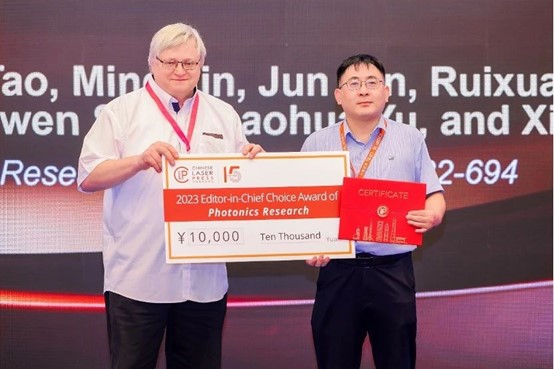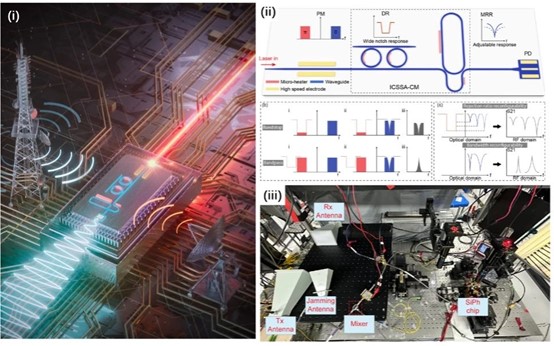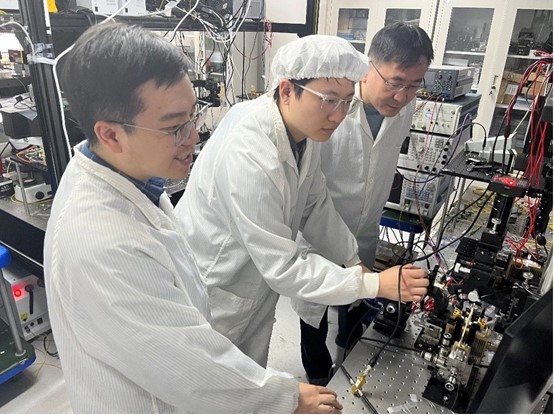Recently, Photonics Research 2023 Editor-in-Chief's Recommendation Award was re-released at the 15th International Conference on Information Optics and Photonics (CIOP2024). Professor Lan Yang, Editor-in-Chief of the journal, Professor Yuri Kivshar, Australian National University, and Professor Yu'ao Chen, University of Science and Technology of China, selected two award-winning papers from 250 papers published in the year 2023, taking into account the innovation and scientificity of the manuscripts. The team of Prof. Xingjun Wang and Researcher Hao-Wen Shu from the Centre published their paper entitled ‘Highly reconfigurable silicon integrated microwave photonic filter towards next-generation wireless communication’ in Photonics Research, Vol. 5, No. 5, 2023. The paper proposes a multifunctional and novel microwave filter chip based on silicon photonic integration technology, which simultaneously meets the demands for high reconfigurability and reduced control complexity, and provides a wider frequency operation range and more diverse filtering functions for next-generation wireless communication.

Fig. 1 Associate Editor Yuri Kivshar (left) presenting the award to the author's representative, Prof Wang Xingjun (right) of Peking University
Microwave photonic filters have received extensive attention from both academia and industry due to their wide frequency range tunability and versatile filtering characteristics. The emerging photonic integration technology can also effectively overcome the barriers of size, reliability and cost. Therefore, as a key component of RF front-end, integrated microwave photonic filter chips can effectively solve the above problems and become one of the most promising technology paths to the next generation of wireless communications. The silicon chip architecture developed by the team of Prof. Xingjun Wang and Researcher Haowen Shu can be divided into four parts: the phase modulator serves as the input of the RF signal to modulate the electrical signal into the optical domain; the dual ring can be used as a switch to shape the modulation format, modulate the lower sideband of the phase modulation signal, and achieve the switching of the band-pass and band-stop functions; the tunable micro-ring is the core unit of the signal processing, and the coupling area consists of an asymmetric Mach-Zehnder interferometer, which can change the Q value of the micro-ring, and at the same time, it can further realise the functions of adjustable passband and adjustable rejection of the stopband rejection with the double ring; the photodetector acts as the output of the RF signal, and recovers the RF signal from the optical signal. Experimental tests demonstrate the excellent working performance of the filter, with a tuning range of up to 30 GHz, a 3-dB passband bandwidth adjustable from ~200 MHz to ~2 GHz, and a maximum stopband rejection ratio of up to 61 dB. In the mirror interference suppression experiments, the error vector magnitude (EVM) of the received signals is reduced from 64.43% to 24.48%, which proves the silicon-based chip's filtering performance.

Fig. 2 (i) Conceptual diagram of a microwave photonic filter chip applied to a wireless communication scenario. (ii) Filter architecture and working principle. (iii) Simulated wireless scenario experiment
Lan Yang, Editor-in-Chief of Photonics Research, commented on the paper, “An interdisciplinary team including several research institutions led by Professor Xingjun Wang and Researcher Haowen Shu at Peking University has developed a highly reconfigurable silicon integrated microwave photonic filter, which reveals the importance of integrated photonics for the next-generation wireless communications. The work aims to address key challenges faced in the rapidly evolving field of wireless communications, in particular the need for more compact, efficient, and multifunctional systems. The integration of all core components onto a single chip significantly reduces the size and power consumption of the system, paving the way for more scalable and cost-effective solutions to be proposed. The filter enables a wide frequency tuning range extending to the millimetre-wave band (up to 30 GHz), along with high spectral resolution and large rejection ratios, making it adaptable to a wide variety of applications ranging from advanced wireless communication systems and radar technologies to cognitive radios, satellite communications, and next-generation sensing and imaging systems. This work not only advances the technology of integrated photonics, but also lays the groundwork for the development of future high-speed and flexible communication networks, thus helping us to address the growing demand for faster, more reliable and adaptable communication systems in an increasingly connected world.”

Fig. 3 Professor Xingjun Wang (right) and Researcher Haowen Shu (left) guiding article one, Zihan Tao (middle), to set up the wireless communication experiment

